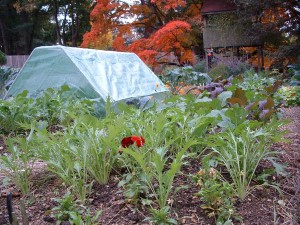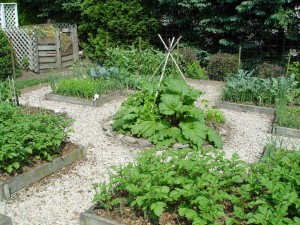Good-Looking Edibles
January 6th, 2012
Just because a garden is filled with edible plants doesn’t mean it has to be ugly.
So if you’re torn between eating better (and cheaper) vs. “ruining” the back yard, think again. This is one case where you canhave it both ways.
Vegetable gardens would look a lot better if we stopped trying to copy what farmers do, says Lower Paxton Twp. vegetable gardener Kenny Point. We don’t need vast rectangles, long single rows and 4-foot-wide paths since we don’t have to worry about driving tractors through it all.
Point’s point is that a home vegetable garden looks better, yields better and is much easier to care for when it’s planted in wide, raised beds and mixed blocks instead of skinny, single-crop rows. (For more Point pointers, check out www.veggiegardeningtips.com.)
His own garden consists of four, 5-foot-wide raised beds that are good-looking enough that they once earned one of the top three awards in a Patriot-News garden contest. That was competing against conventional ornamental landscapes.
“I’ve just had such better results since switching from a row format to growing in raised beds that there is no comparison and no way I would go back to the traditional format,” Point says.
Block planting lets him mix and match many different plants according to their colors, textures and sizes.
When you think about it, edible plants have plenty of ornamental characteristics, too.
Carrots have frilly foliage. Purple cabbage has wide, colorful leaves. Hot peppers have fruits that ripen in all sorts of bright colors and shapes. And ‘Bull’s Blood’ red beets have some of the darkest leaves this side of coralbells.
The problem is we don’t take advantage of the great pairings these plants could generate.
Instead, tradition tells us to line up a single plant until the row ends, then switch to something else next row over.
That not only looks boring, but it doesn’t make sense when the goal no longer is to harvest gobs of stuff all at the same time in order to can or freeze it.
These days the trend is toward growing a wider variety of produce for fresh eating – particularly items that are expensive or hard to find at the grocery store.
Point says he doesn’t set out to design a decorative vegetable garden. It just works out that way.
“I focus on mixing things up by planting a good variety of plants, keeping them healthy and managing the garden to avoid barren, unproductive areas,” he says. “I do make use of good accent ornamental veggie plants like palm kale, exotic looking cardoons and colorful rainbow chards.”
Point even mixes in herbs and, yes, flowers – mainly to attract “good bugs” that feed on the pests but also to add color and interest.
Across the river in the Carlisle countryside, John Greenbaum arrived at the same conclusion.
His family veggie garden also is laid out in 4- to 5-foot-wide raised beds that veer off at right angles from a central wood-mulch path.
The whole garden is situated below a swimming pool on a back-yard terrace that’s surrounded by a wooden fence on three sides and a stone wall at the pool end.
Vining crops grow on the fence and on stand-alone trellises. Some are ornamental climbers, such as purple-blooming hyacinth beans and white moonflowers, while others are edible, such as cucumbers, grapes, peas and pole beans.
This garden has even more flowers than Point’s – about 25 percent flowers to 75 percent edibles. All except for a few nursery-bought marigolds are direct-seeded annuals such as cosmos, zinnias and annual dahlias.
Like Point, the Greenbaums’ garden is a good-looking award-winner – taking an honorable mention in the 2008 Central Pa. Magazine “Art of Gardening” contest against all ornamental entries. But unlike Point, Greenbaum consciously shoots for a garden that looks as good as it tastes.
“Since we spend so much time around the pool in the summer, we want the garden to look attractive,” Greenbaum says. “I try to mix in flowers as well as have some new crops growing throughout the growing season. I avoid plants that will die and leave empty patches, like potatoes. I put unattractive plants in a separate garden.”
Keeping a veggie garden full and good-looking all season is a little trickier than, say, a flower or shrub bed, because the point of veggies is harvesting them.
Greenbaum says the answer is succession planting – staggering the sowing and constantly replacing tired and/or harvested crops with fresh ones. This also maximizes production and keeps a steady supply of fresh produce on the table all season.
“I like to have continuous harvests,” says Greenbaum. “For crops that we like to eat throughout the summer, I plant a new crop in a new block every two weeks. For instance, I’ll plant spinach and lettuce on May 1 in a block about 4 to 5 feet across, using about 5 or 6 feet of a 40-foot row. On May 15, I’ll repeat that in a space farther down the row and on June 1 again elsewhere in the garden.
“When a block of greens goes to seed, I’ll tear it out and plant another fast-growing crop in its place. I do this for lettuces, beans, basil, cucumbers, Swiss chard, beets and more.”
(For some of the best specific veggie varieties to try, click here.)
Greenbaum also plants short greens such as lettuce and spinach along the edges of bigger, season-long plants such as tomatoes and peppers. By the time the greens are picked, the tomatoes and peppers are taking over the space.
Keeping the beds planted has the side benefit of warding off weeds – a sure-fire headache any time there’s bare dirt left behind.
Both Greenbaum and Point will tell you this really doesn’t take as much work as you think.
It amounts to frequent light putterings, watering and small replantings rather than the back-breaking tilling, hoeing and all-at-one-time planting of a traditional veggie garden.
That kind of work demand is what causes a traditional veggie garden to end up looking so tattered and weed-infested by summer’s end, says Point.
People bite off too much in May, he says, get worn out by the built-in deficiencies of farm-copying and give up after falling behind.
“This can be avoided by consistently devoting as little as 30 minutes of your time two or three times a week rather than playing catch-up or resorting to marathon sessions after things have gotten out of hand,” Point says.
Either way, the good news is that with an edible garden, at least you’ll have something to eat in the end to recharge your energy.
That is, unless the groundhogs breach your good-looking fence.
More ways to make your edible garden look good:
1.) Lay out your edible garden in a geometric pattern. The classic favorite is a Pennsylvania German four-square design, which features a central circle or block with paths splitting the remaining space into four separate corner gardens. Or consider a wagon-wheel pattern, a series of triangles or any design that strikes your fancy. Just keep the planting beds about 4 to 5 feet wide so you can reach in without stepping on the soil.
2.) Think about hardscaping. Define the garden with permanent features such as stone paths between the beds, walls or fencing around the perimeter and maybe a vine-covered arbor at the entrance.
3.) Upgrade the accessories. Instead of plain wooden tomato stakes and utilitarian vine netting, switch to more ornamental trellises or build attractive bamboo teepees.
4.) Add a few focal points to key spots. These could include objects such as statues, bird feeders, bee skeps and favorite antiques and/or specimen plants such as cardoon, rhubarb or a fig tree.
5.) Pair plants as you would with ornamentals, i.e. by size, by color and by form and texture. You don’t have to plant veggies in isolated lines. A cluster of spiky onions, for instance, might look good flanked by trios of red lettuce and back-dropped by taller pepper plants. Spot a few gold or red zinnias to finish it off.
6.) It’s OK to repeat small amounts of a particular edible throughout the garden. This also makes it harder for bugs and animal pests to find everything.
7.) Lean toward colorful veggies, herbs and edible varieties. Some of the best and brightest: ‘Bright Lights’ chard, Malabar spinach, purple cabbage, red lettuces, lavender eggplants, ‘Chilly Chili’ and other colorful hot peppers, purple basil, golden oregano, ‘Tricolor’ and ‘Pineapple’ sages and blue-leafed kale.
8.) All edibles don’t have to go in an edible garden. Tuck veggies, herbs and fruiting shrubs in the landscape. Hot peppers go great with most annual flowers. Blueberries make a beautiful flowering and fall-foliage shrub. Eggplants and purple basil make a nice pot combination. Go by how a plant looks and what it does, not by the category it’s labeled under.










